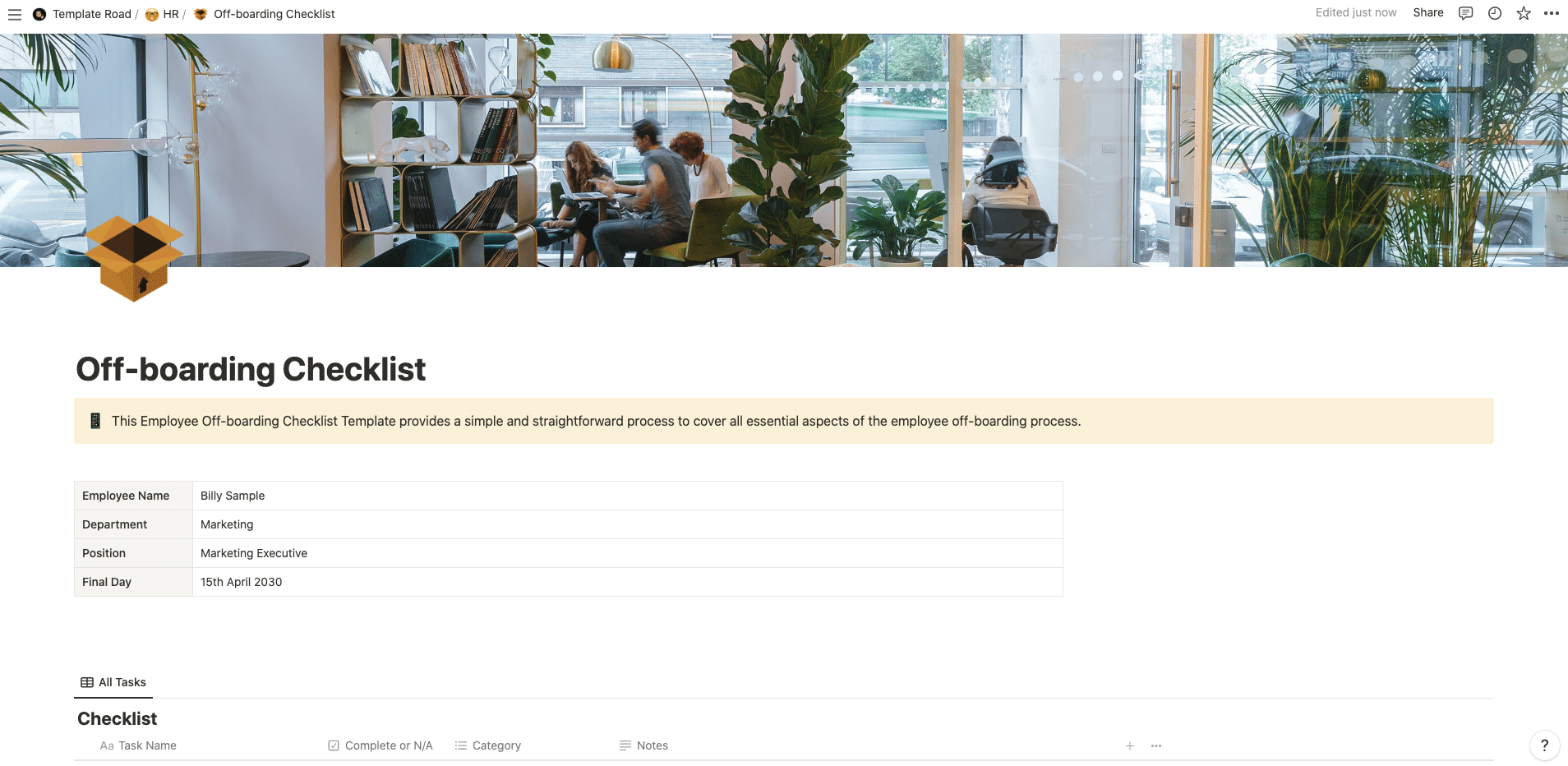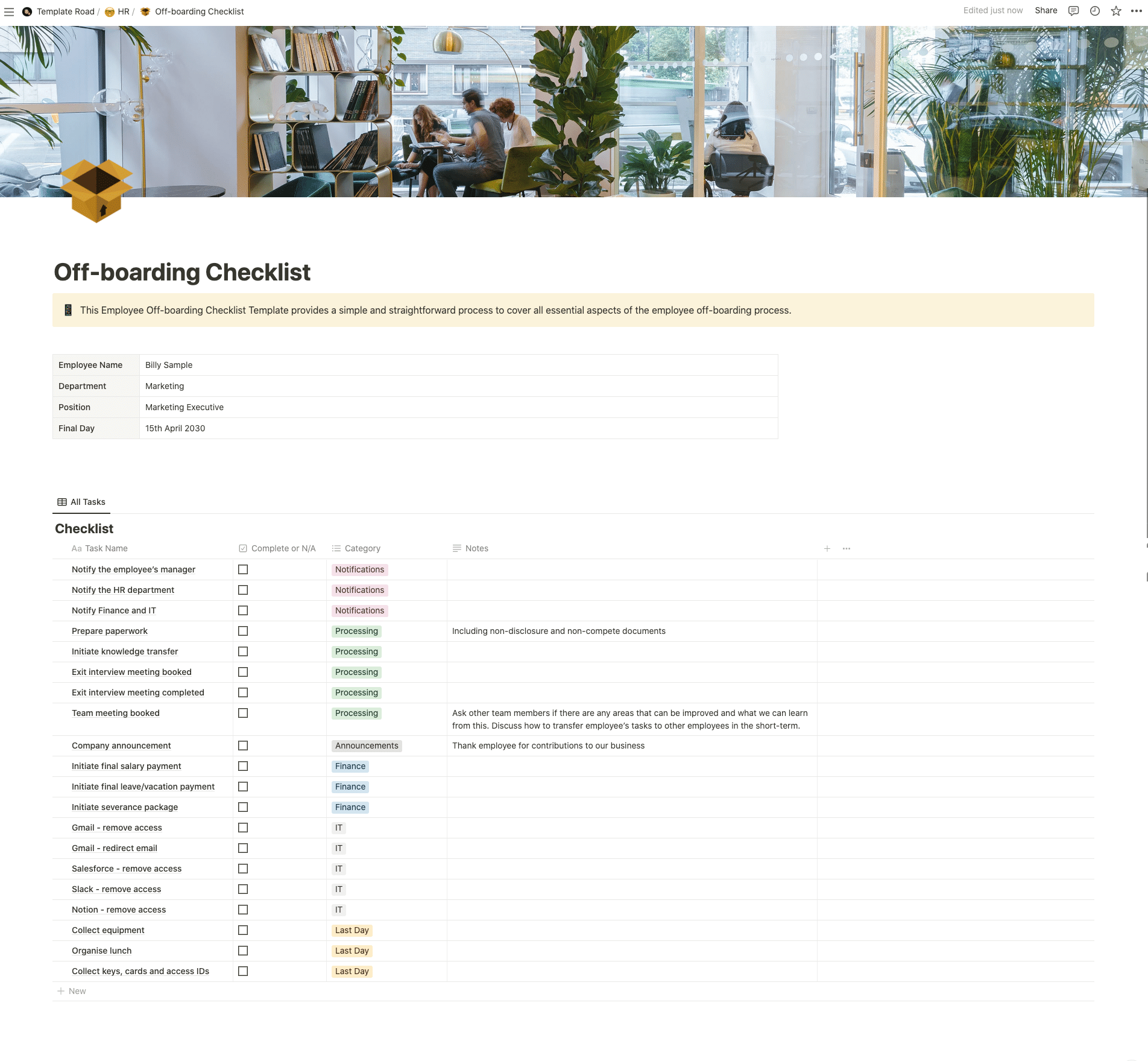This Employee Offboarding Checklist Template provides a simple and straightforward process to cover all essential aspects of the employee off-boarding process.
Buy on
Contents
Notion – Off-Boarding Checklist Template
This Employee Offboarding Checklist Template provides a simple and straightforward process to cover all essential aspects of the employee off-boarding process including returning company equipment. By eliminating potential complications during equipment return, this template saves time and resources. For business owners who want to streamline their offboarding and equipment return process, this checklist can be extremely beneficial.
——————————————
What you need before purchase
- Basic knowledge of how to use Notion
- Paid Notion account if you want to add lots of content to your template / Notion account (sign up here). Not much content? You’re able to use their free account.
After purchase, you’ll be able to view the template immediately. The template can be added to your Notion account by:
- Click on the template download link in Gumroad
- When viewing the Notion template, click on the “Duplicate” link in the top-right of your screen
- The template will now be available in your own Notion account
What is employee offboarding?
Employee offboarding is the process of transitioning an employee out of a company or organization. It is used to ensure that all legal, financial, and administrative requirements are met during the process and to help maintain a positive relationship between both parties. The goal of an effective offboarding program should be to create a smooth transition for both the departing employee and the organization.
The Offboarding Process: How to Transition Employees Smoothly
- Set expectations early: Make a plan to address the needs of both the employee and organization during this transition. This should include setting formal timelines, communication guidelines, and outlining any necessary paperwork.
- Provide support: Provide support to the departing employee in terms of helping them transition their work responsibilities, offering outplacement services if appropriate, and helping them with any final paperwork or other administrative needs.
- Inform colleagues: When an employee leaves, it’s important to inform their colleagues and supervisors so that there is a smooth transition of responsibilities and tasks.
- Keep in touch: Stay in touch with the departing employee, even after they have left the organization. This will help foster good relationships and can be helpful for future referral or networking opportunities.
- Collect and analyze feedback: Gather feedback from the departing employee after they have left the organization. This can provide valuable insights into how the offboarding process can be improved in the future.
- Document lessons learned: Document any lessons learned during the offboarding process and use them to create better processes and procedures going forward.
- Celebrate successes: Take the time to celebrate the successes of the departing employee. This can be a great way to end on a positive note and help maintain a good relationship between both parties.
Employee offboarding is an important process for any organization that wants to ensure smooth transitions and maintain positive relationships with their employees. By following these steps, you can create a successful transition program that meets the needs of both the organization and its employees.
What Is the Difference Between Onboarding and Offboarding?
The main difference between onboarding and offboarding is that onboarding is the process of orienting a new hire and providing them with the necessary resources, tools, training, and support to enable them to become successful in their job. Offboarding is the process of transitioning an employee out of a company or organization. It is used to ensure that all legal, financial, and administrative requirements are met during the process and to help maintain a positive relationship between both parties.
What do I put in an exit interview checklist?
An exit interview checklist should include items such as:
- Collecting employee feedback: Ask the employee questions about their experience working at the company and any areas they may have identified for improvement.
- Gathering information on benefits and compensation: Clarify any questions the employee may have pertaining to compensation and benefits, such as final paychecks, accrued vacation time, and stock options.
- Obtaining contact information:
- Returning property: Ensure that all company property, such as laptops, phones, and office keys are returned to the appropriate personnel before an employee leaves.
- Collecting feedback from colleagues: Ask the departing employee’s colleagues for their feedback on any areas of improvement or areas where they excelled during their employment with the company.
- Determining next steps: Clarify the employee’s next steps in terms of any administrative tasks, references, or additional paperwork that needs to be completed before they leave.
- Documenting the process: Ensure that all documentation relating to the offboarding process is accurate and up-to-date, including any written communications with the employee, the paperwork they have signed, and any other relevant materials.
- Maintaining records: Retain records of the offboarding process in accordance with legal requirements, such as any termination agreement or non-disclosure agreement signed by the employee.




















